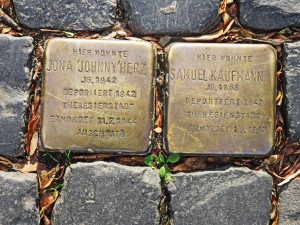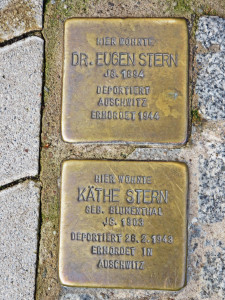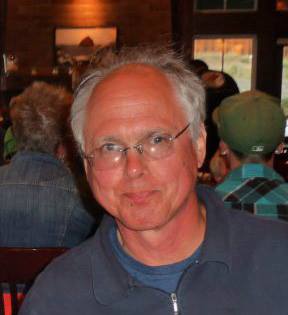Spotlight: Stumbling: Cut Short
[creative nonfiction]
SILENT MEMORIALS
Our eyes tripped over a four-by-four inch bronze memorial embedded in a sidewalk in Cologne, Germany:
Hier wohnte
Jona ‘Johnny’ Herz
J.G. 1942
Deportiert 1942
Theresienstadt
Ermordet 11.7.1944
Auschwitz
Or, in English, “here lived Jonah ‘Johnny’ Herz, born in 1942, deported to Theresienstadt (as a newborn), murdered on July 11, 1944.” It immediately struck us, first, they sent a newborn to Theresienstadt; second, little Johnny survived a long time, considering. Alongside Johnny’s memorial lay a second memorial that read, “Here lived Samuel Kaufmann, born in 1868, deported to Theresienstadt in 1942, murdered on September 1, 1942.” Unlike the infant, the old man, who was already seventy-four years old when he was exiled to Theresienstadt, didn’t last long. We thought: Samuel didn’t last long, probably because Theresienstadt provided almost no health care; and, yes, murder is the right word.
 In Koblenz, we saw memorials outside the former home of Dr. Eugene Stern, born in 1894, and Kaethe Stern (nee Blumenthal), born in 1903, deported, murdered in Auschwitz 1944. Stern was my Jewish grandmother’s family name, so this struck home.
In Koblenz, we saw memorials outside the former home of Dr. Eugene Stern, born in 1894, and Kaethe Stern (nee Blumenthal), born in 1903, deported, murdered in Auschwitz 1944. Stern was my Jewish grandmother’s family name, so this struck home.
Easily mistaken for cobblestones, each Stolpersteine or “stumbling stone,” remembers one persecuted or murdered victim of National Socialism, 1933-1945, including survivors of the Holocaust. The Stolpersteine project began in Cologne in 1995 to remember Sinti and Roma murdered in the Holocaust, but quickly was broadened to include all persecuted or murdered Holocaust victims. The vast majority memorialize Jews, but also remember others offensive to National Socialism including Romani, Sinti, gays, blacks, physically and mentally disabled, forced laborers, Jehovah’s Witnesses, military deserters, POWs, and those who provided refuge and protection.
Most Stolpersteine begin “Hier wohnte,” meaning “here lived,” others begin: “here worked,” “here practiced,” “here taught,” “here studied.” Most are placed at an individual’s last chosen place of residence. By returning victims to their neighborhoods, Stolpersteine remind passersby that victims were torn away, and most likely murdered. It says to passersby, “You are standing in what was once their space. They once breathed the same air you’re breathing now.”
The overwhelming majority of Stolpersteine are located in Germany. Some locations, such as Berlin, have large clusters of Stolpersteine—hundreds of them—to memorialize individually each resident of certain apartment buildings. Across 1,000 locations in eighteen countries, nearly 50,000 people are memorialized by Stolpersteine. There’s a catch in the name because, at one level, it reminds us that, in World War II, there were some major stumbles in recognizing basic human rights. At another level, this is a pun because, before the Shoah, when someone in Germany tripped over a cobblestone, people often cracked an anti-Semitic joke: “There must be a Jew buried there.” This dual meaning captured the irony in calling them stumbling stones. In practice, stumbling stones are placed flush with surrounding sidewalk or cobblestones, so they pose no real risk of tripping up passersby.
In Bamberg—a city in Bavaria that largely escaped the devastation of World War II bombings, and a UNESCO World Heritage Site—we came across a memorial to a different type of war victim: “Here was shot Bernard Delachaux, born in 1914, a French soldier and prisoner of war who died March 24, 1942.”
 Later, on a busy street in Bamberg’s shopping district, we came upon a cluster of five newly-installed, brightly-polished Stolpersteine. What caught our attention was a six-year-old boy, out with his mom and three-year-old sister. The boy went down on one knee and read clearly, slowly, solemnly: “Here lived Rosa Brueckmann, born 1868, deported Theresienstadt 1942, murdered Treblinka.” Then another for Fanny, born seven years earlier, likewise deported and murdered. He then read the Stolpersteine for the Hahn family: Heinrich and Martha deported from Riga in 1941, and there murdered, Heinrich in April 1, 1943. Their son Martin, fled to Holland in 1938, interred in Westerbork en route to Mauthausen (where Anne Frank later died of typhoid), and there murdered December 12, 1942. Heinrich outlived his son by several months. The boy’s mom didn’t say, “Hurry, you’re wasting my time, it’s time to move along.” She let him take his time to read. No laughter, no playing. The boy seemed to understand too, at least as well as anyone could. No need for commentary. Done, the boy reached out and took mom’s hand, stood, and the three walked on.
Later, on a busy street in Bamberg’s shopping district, we came upon a cluster of five newly-installed, brightly-polished Stolpersteine. What caught our attention was a six-year-old boy, out with his mom and three-year-old sister. The boy went down on one knee and read clearly, slowly, solemnly: “Here lived Rosa Brueckmann, born 1868, deported Theresienstadt 1942, murdered Treblinka.” Then another for Fanny, born seven years earlier, likewise deported and murdered. He then read the Stolpersteine for the Hahn family: Heinrich and Martha deported from Riga in 1941, and there murdered, Heinrich in April 1, 1943. Their son Martin, fled to Holland in 1938, interred in Westerbork en route to Mauthausen (where Anne Frank later died of typhoid), and there murdered December 12, 1942. Heinrich outlived his son by several months. The boy’s mom didn’t say, “Hurry, you’re wasting my time, it’s time to move along.” She let him take his time to read. No laughter, no playing. The boy seemed to understand too, at least as well as anyone could. No need for commentary. Done, the boy reached out and took mom’s hand, stood, and the three walked on.
The power of these little memorials is that they say so little: someone was born, lived, was sent to a concentration camp, and there they were murdered. Occasionally, they tell the story of someone who deserted, or was shot and taken prisoner of war, or who escaped to freedom (leaving behind their home, possessions, and what remained of their community), or who was killed elsewhere other than in a camp.
The Stolpersteine project keeps expanding slowly. Across 1,000 locations in eighteen countries, nearly 50,000 people are memorialized by Stolpersteine. German artist Gunter Demnig coordinates the project and travels throughout Europe to oversee directly the installation of the memorial stones. While in theory the intent is to acknowledge every Holocaust victim individually, Demnig does not expect to see that day. He has no interest in stepping up production of mass-producing stumbling stones, because doing so would mimic the mass annihilations perpetrated by the National Socialists. Moreover, installing Stolpersteine requires cooperation from host communities and from the living family of Holocaust victims. It costs 120 Euros to sponsor the creation and installation of one Stolpersteine.
Demnig quotes the Talmud as saying, “A person is forgotten only when his or her name is forgotten.” The memorial stones ask us to stumble for a moment in silence to remember, “one stone for one name.” Perhaps in that remembering we can find our own silence. If so, it is a silence uncomfortable with injustice of all sorts and, above all, at odds with the collective silence that once masked the Holocaust atrocities.
SECRETARIAT
Ignoring any reasonable protocol for treadmill running, she sashayed her head from side to side as she ran, like a horse trying to shake off water. Her arms occasionally reached out to either side, front, and overhead, as if she danced. Once, she became fixated on adjusting a belt clip, and nearly dropped off the treadmill’s end. She sang quietly to music on her iPod except, every minute or two, she belted out the lyrics, and made even more extreme movements. Her bursts in volume, screechy tone, and extreme gesticulations caught the attention of everyone nearby. Now and then, she checked text messages. After each, she shouted a drawn out, “ha-a-a-a-a-A-A-A!” that became progressively louder before ending with a sharp expulsion of air. After a while, she stopped dancing, and started punching the air in front of her, left, right, left, right. Once, she bent half over and looked like she picked imaginary flowers. Maybe when she sashayed her head back and forth, right to left, and when she punched the air, she meant to be a boxer bobbing and weaving, he thought, watching her on his left, but she looked far more like a punchy horse.
Without breaking stride, she slowly pulled a blue sweatshirt over her head with her right hand, yanking a white t-shirt back down with her left hand. Her head continued to sashay back and forth, and she kept running with her arms moving like a dancer’s arms. She wore neon orange shoes. Her shorts were pink with green trim. Her gnarly, dirty blond hair was tied up behind her head in a bunch, not a bun or pony tail. She was probably about 20, he figured. After about 25 minutes, she switched from running 10 minute miles to walking at a 15 minute clip.
“That’s an interesting running style you have there,” he said.
She turned to him and gave back a goofy smile. “Oh, I don’t have any idea how to run. My sisters both ran track. I’m just learning how.”
“Why didn’t you learn before?” he asked.
“I had an accident. It was in New Orleans. I was riding a bike and was hit by a truck. There was a big law suit. I was never supposed to walk again,” she said.
“But look at you!” he said.
“Don’t tell the lawyer I’m running now,” she said, with an even goofier smile.
“I can imagine what it was like,” he said. “I lost use of my foot two years ago. The nerve died.”
“Me too. And I had five operations on my foot so it would work again.”
“Looks like it worked,” he said.
“But I still have no idea how to run. I’ve always done things like being a goalie in soccer or the catcher in softball, things were I could throw my whole body at things,” she said.
“Looks like you’re still doing that,” he said.
“I still need to give up smoking,” she said.
“That would be one of the best things you could do for yourself,” he said.
“I will. I plan to. But I can’t give up everything all at once,” she said.
“When you run, you look more like a horse running on a track,” he said.
“Ha-a-a-a-a-A-A-A!” she said, with an explosion at the end. “My sisters always said I had horse hair.”
“I don’t know about your hair,” he said, although he could see exactly why her sisters said it, “but you don’t run like anyone I’ve ever seen run. You look like a horse.”
“I’ll take that as a compliment,” she said.
“I mean it that way too. Seabiscuit,” he said.
“No, Secretariat. I want to be Secretariat,” she said.
“You got it,” he said. “I gotta go. See ya, Secretariat. Keep on running.”
When he walked by 20 minutes later, she had resumed running at a 10 minute clip. Her head sashayed back and forth. Her arms flew in every direction. She occasionally punched the air rapidly, with a left-right-left-right motion. Now and then, she checked text messages and let out a loud, “ha-a-a-a-a-A-A-A!,” or she let out a loud cry that drew attention from everyone nearby. Perhaps, he thought, this is what we’d all look like in dreams if we ran from some unspecified threat, propelled forward by forces exceeding our invested effort.
The next day, he read that a documentary called “Secretariat’s Jockey Ron Turcotte” was about to appear at a nearby theater for only one screening seven days away. The film was about Ron Turcotte, who won the Triple Crown riding Secretariat’s back. It contains never-before-seen footage about Secretariat but that’s not why horse girl needs to see this, he thought. It’s Turcotte! Just like horse girl, Turcotte fought his way back after a 1978 fall left him a paraplegic. Back to the people and places that marked his life. Horse girl has to see this. Wait, Turcotte’s actually going to be there with the film. So is Secretariat’s owner, Penny Chenery. There’s a Q&A with them after the film. Horse girl’s adrenaline’s going to soar.
He bought two tickets, put them in an envelope, sealed it, and was about to write her name on it when he realized he didn’t know her name. He took the envelope with him to the Y the next night at roughly the same time as when he’d run on the treadmill next to her. She wasn’t there. He went back again every night for two hours at roughly the same time. He even went one morning and early one afternoon. He asked around, but nobody knew her. Two days before the screening, he heard they were looking for people to participate in an hour-long taping of a PBS show about Secretariat right before the screening. Horse girl will be perfect, he thought. She’ll just love this. But he never saw horse girl again. Nobody used the tickets.
WHAT IS YOUR NEED?
In October 2010, after walking on le chemin St. Jacques by myself, and never being certain where I would spend the night, I had to return to Paris to catch a return flight to the United States. On my last night in Paris where I was staying in the residential 19th ward, I went out for a brief walk to investigate the St. Martin’s Canal nearby. At the bottom of the street, I passed two women who were standing upright and stoically, almost like statues, next to what looked out of the corner of my eye like a pile of backpacks. Both were dressed in black. One wore a hood that almost entirely covered her face. The other had a hood, but her emotionless face was completely visible. When I returned from a quick trip to the canal, they were still there, and I passed without stopping because I was thinking about dinner and the Affligem blonde I was going to wash it down with. But, when I got back to my hotel room, all I could think about was the two women and their backpacks. The one woman’s face stayed with me. I had to go back and try to establish a connection if only to find out why they were there so late in the day guarding a pile of backpacks.
When I got back to the two women, the one whose face was visible had removed her hood. I also could readily see that the backpacks were actually a gigantic shopping cart stuffed with luggage, other possessions, and multiple water bottles. There was none of the usual evidence of homelessness. They both stood upright rather than sitting or lying on the ground. Instead, they stood upright, with excellent posture, like sentries. They had no bowl or cup. They did not reach out a hand to passersby or make other entreaties to strangers to ameliorate their life conditions. I tried to start a conversation and learned quickly that the older one spoke no English, but the younger one spoke English fairly fluently. I estimate she was about 30 and the older one about 65. They passed cigarettes back and forth between them. About 15 minute into the conversation, I tried to hand the younger a 10 Euro note. After and conferring with the older one—she conferred before answering nearly every question—she said, “You don’t have to pay us to talk with us.” I put my money away for the time being.
We continued to talk for nearly an hour and a half. I learned that they were two university-educated women, mother and daughter, the bottom of whose life fell out. Their message was this could happen to anyone, it could even happen to you. From day to day, they didn’t know where they would sleep that night. I offered them money once or twice more, and again they refused it. Occasionally, I asked them a question they chose not to answer, to which they said, “You don’t need to know that.” After a while, I realized they were asking me at least as many questions as I was asking them. Finally, the daughter said to me, “People stop and ask us questions because they have a need. What made you come back? Why did you stop? Why do you want to talk with us and hear our pain? What is your need?” I thought for a moment, and all I could think to say was, “I saw your face.”
It had turned dark and they said they need to go and find a place to spend the night. My heart said I should offer them my hotel room, but I knew that the hotel was already very guarded about who they allowed in. I stuffed 20 EU in the daughter’s hands. I closed her hand on the money and held her hand shut. I looked her in the eyes and she looked back at me. The mother spoke and the daughter translated. She said, “We accept your money and we thank you. We will use it to buy food.”
There’s more to the story, but what stayed with me was her question, “What is your need?” I have asked myself that question many times. And, I’ve also wondered, who really were they? Were they truly a mother and daughter on hard times? Were they a professor and doctoral student collecting data? Were they political activists out to play on the public’s compassion for the plight of the homeless? I wanted to go back and find out at the minute I left Paris, but the answer really doesn’t matter. All that matters was their question, “What is your need?”
 Jim Ross is a newly retired public health researcher. He’s recently published poetry, stories, or photographs in The Atlantic, Pif Magazine, Friends Journal, The Sun, Cahoodaloodaling, Dirty Chai, and several other journals. Forthcoming work includes photo essays in Cargo Lit and In the Fray and poems in Work Literary Magazine. Jim and his wife split their time between Maryland and West Virginia. They looking forward passionately to becoming grandparents of twins this summer.
Jim Ross is a newly retired public health researcher. He’s recently published poetry, stories, or photographs in The Atlantic, Pif Magazine, Friends Journal, The Sun, Cahoodaloodaling, Dirty Chai, and several other journals. Forthcoming work includes photo essays in Cargo Lit and In the Fray and poems in Work Literary Magazine. Jim and his wife split their time between Maryland and West Virginia. They looking forward passionately to becoming grandparents of twins this summer.





